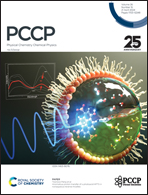A first-principles study of the BC3N2 monolayer and a BC3N2/graphene heterostructure as promising anode materials for sodium-ion batteries†
Abstract
High-performance sodium-ion batteries (SIBs) require anode materials with high capacity and fast kinetics. Based on first-principles calculations, we propose BC3N2 and BC3N2/graphene (B/G) heterostructure as potential SIB anode materials. The BC3N2 monolayer exhibits intrinsic metallic behavior. In addition, BC3N2 possesses a low Na+ diffusion barrier (0.15 eV), a high storage capacity (777 mA h g−1), a low open-circuit voltage (0.72 V), and a tiny axial expansion (0.36%). Compared with the BC3N2 monolayer, the B/G heterostructure exhibits a lower diffusion barrier of 0.027 eV, suggesting a much faster diffusion. More importantly, although the B/G heterostructure possesses heavier molar weight, its theoretical capacity (689 mA h g−1) is comparable to that of the BC3N2 monolayer. Based on the above-mentioned properties, we hope both the BC3N2 monolayer and the B/G heterostructure would be promising anodes for SIBs.



 Please wait while we load your content...
Please wait while we load your content...